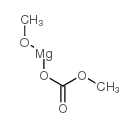Magnesium methyl carbonate solution

Magnesium methyl carbonate solution structure
|
Common Name | Magnesium methyl carbonate solution | ||
|---|---|---|---|---|
| CAS Number | 4861-79-4 | Molecular Weight | 130.38200 | |
| Density | 1.103 g/mL at 25ºC | Boiling Point | 378.8ºC at 760 mmHg | |
| Molecular Formula | C3H6MgO4 | Melting Point | N/A | |
| MSDS | N/A | Flash Point | 52 °F | |
| Symbol |



GHS02, GHS06, GHS08 |
Signal Word | Danger | |
|
Celastrol induces proteasomal degradation of FANCD2 to sensitize lung cancer cells to DNA crosslinking agents.
Cancer Sci. 106 , 902-8, (2015) The Fanconi anemia (FA) pathway plays a key role in interstrand crosslink (ICL) repair and maintenance of the genomic stability, while inhibition of this pathway may sensitize cancer cells to DNA ICL agents and ionizing radiation (IR). The active FA core comp... |
|
|
Functional Genetic Screen Identifies Increased Sensitivity to WEE1 Inhibition in Cells with Defects in Fanconi Anemia and HR Pathways.
Mol. Cancer Ther. 14 , 865-76, (2015) WEE1 kinase regulates CDK1 and CDK2 activity to facilitate DNA replication during S-phase and to prevent unscheduled entry into mitosis. WEE1 inhibitors synergize with DNA-damaging agents that arrest cells in S-phase by triggering direct mitotic entry without... |
|
|
In vitro toxicological assessment of iron oxide, aluminium oxide and copper nanoparticles in prokaryotic and eukaryotic cell types.
Drug Chem. Toxicol. 38 , 152-61, (2015) Metallic nanoparticles (NPs) have a variety of applications in different industries including pharmaceutical industry where these NPs are used mainly for image analysis and drug delivery. The increasing interest in nanotechnology is largely associated with un... |
|
|
Defining the property space for chromatographic ligands from a homologous series of mixed-mode ligands.
J. Chromatogr. A. 1407 , 58-68, (2015) A homologous ligand library based on the commercially-available Nuvia cPrime ligand was generated to systematically explore various features of a multimodal cation-exchange ligand and to identify structural variants that had significantly altered chromatograp... |
|
|
High-dose chemotherapeutics of intravesical chemotherapy rapidly induce mitochondrial dysfunction in bladder cancer-derived spheroids.
Cancer Sci. 106(1) , 69-77, (2015) Non-muscle invasive bladder cancer is treated with intravesical chemotherapy (IVC) after transurethral resection (TUR) to reduce the probability of recurrence. Despite improvement, the recurrence rate remains high. Intravesical chemotherapeutics at high doses... |
|
|
Generation of suppressive blood cells for control of allograft rejection.
Clin. Sci. 128(9) , 593-607, (2015) Our previous studies in rats showed that incubation of monocytic dendritic cells (DCs) with the chemotherapeutic drug mitomycin C (MMC) renders the cells immunosuppressive. Donor-derived MMC-DCs injected into the recipient prior to transplantation prolonged h... |
|
|
¹H, ¹³C, ¹⁵N HMBC, and ¹⁹F NMR spectroscopic characterisation of seized flephedrone, cut with benzocaine.
J. Pharm. Biomed. Anal. 107 , 535-8, (2015) Flephedrone (4-fluoromethcathinone, 4-FMC) was analysed using (1)H, (13)C, (15)N HMBC, and (19)F observe spectroscopy, gas chromatography-flame ionisation detection (GC-FID), and electrospray ionisation-mass spectrometry (ESI-MS). Analysis of four 4-FMC sampl... |
|
|
A novel toxicogenomics-based approach to categorize (non-)genotoxic carcinogens.
Arch. Toxicol. 89 , 2413-27, (2015) Alternative methods to detect non-genotoxic carcinogens are urgently needed, as this class of carcinogens goes undetected in the current testing strategy for carcinogenicity under REACH. A complicating factor is that non-genotoxic carcinogens act through seve... |
|
|
Modified in vivo comet assay detects the genotoxic potential of 14-hydroxycodeinone, an α,β-unsaturated ketone in oxycodone.
Environ. Mol. Mutagen. 56 , 777-87, (2015) 14-Hydroxycodeinone (14-HC) is an α,β-unsaturated ketone impurity found in oxycodone drug substance and has a structural alert for genotoxicity. 14-HC was tested in a combined Modified and Standard Comet Assay to determine if the slight decrease in % Tail DNA... |
|
|
Rad51-mediated replication fork reversal is a global response to genotoxic treatments in human cells.
J. Cell Biol. 208(5) , 563-79, (2015) Replication fork reversal protects forks from breakage after poisoning of Topoisomerase 1. We here investigated fork progression and chromosomal breakage in human cells in response to a panel of sublethal genotoxic treatments, using other topoisomerase poison... |